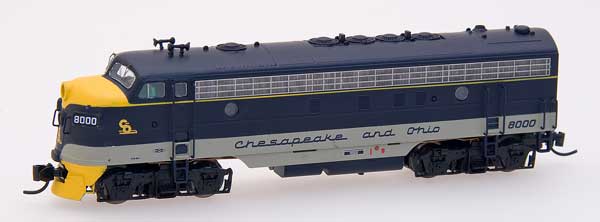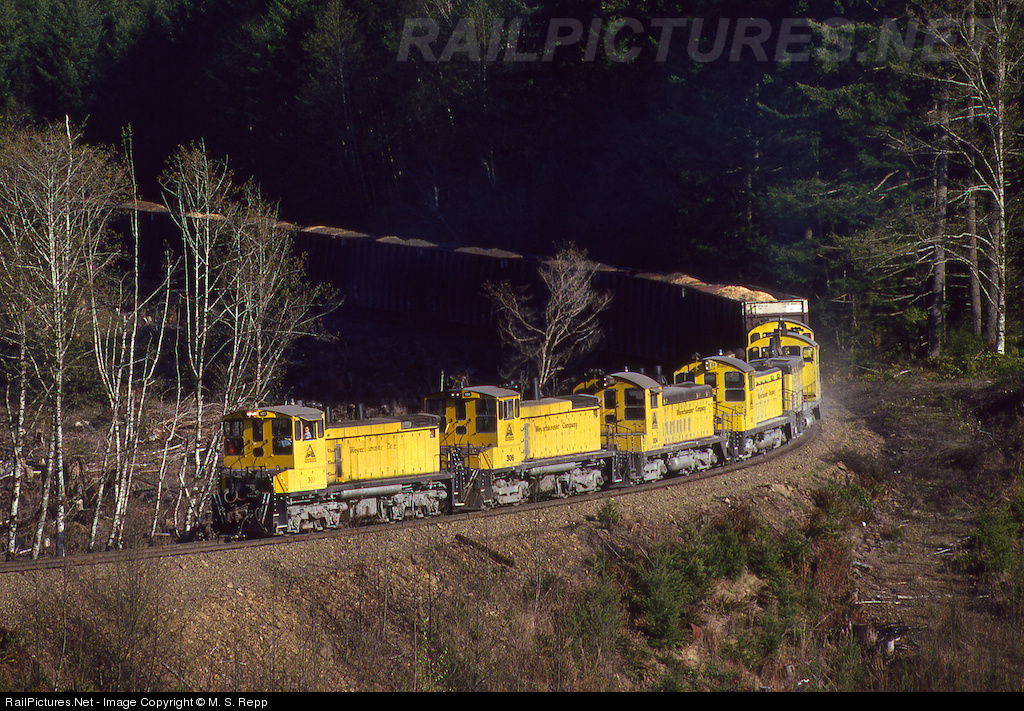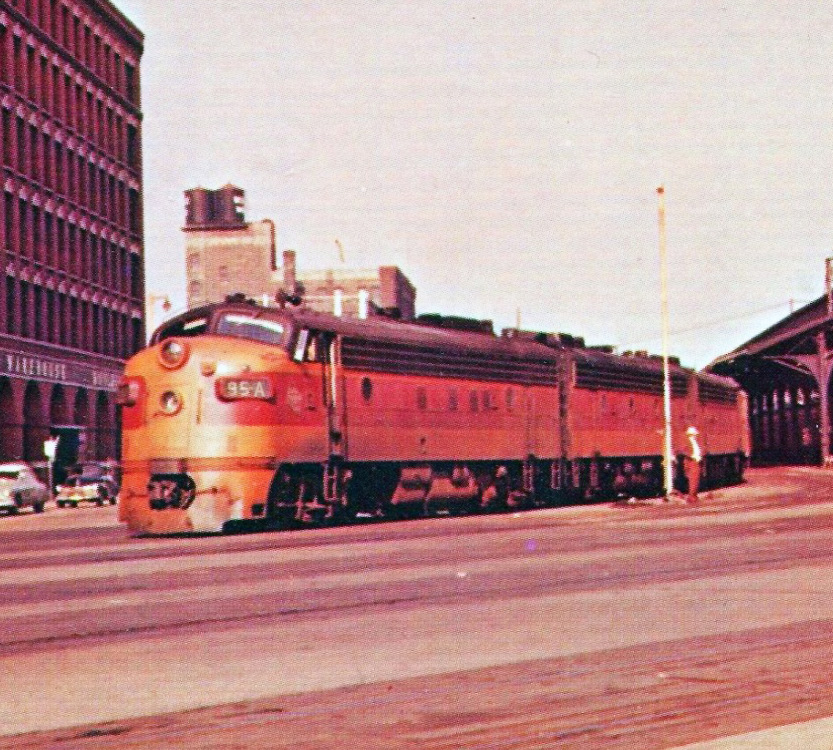Model Information:
Features of this model include (2023 run):
Features of this model include (2023 run):
- LED lighting - All lights separately controllable on DCC units.
- Upper nose MARS Light (where applicable)(single headlight units, upper nose light acts as the headlight)
- Lower Headlight (where applicable)
- Illuminated number boards
- Ditch Lights (DCC only)(No units factory equipped with ditch lights, however LEDs are provided for use by the modeler)
- Wire & Etched metal details
- Laser sharp painting and printing
- Micro-Trains compatible couplers
DCC Information:
The 2023 run is available in 3 versions:
The 2023 run is available in 3 versions:
- DC models equipped with a DC only circuit board and are DCC Ready.
- Non-Sound equipped with an ESU LokPilot 5 DCC decoder (stock number suffixed by letter D)
- Sound units equipped with an ESU LokSound 5 sound decoder. Real F7 locomotive recordings used for superior accuracy and quality! (stock number suffixed by letter S)
Prototype History: The EMD FP7 was a 1,500 horsepower (1,100 kW), B-B dual-service passenger and freight-hauling diesel locomotive produced between June 1949 and December 1953 by General Motors' Electro-Motive Division and General Motors Diesel. Final assembly was at GM-EMD's La Grange, Illinois plant, excepting locomotives destined for Canada, in which case final assembly was at GMD's plant in London, Ontario. The FP7 was essentially EMD's F7A locomotive extended by four feet to give greater water capacity for the steam generator for heating passenger trains.
While EMD's E-units were successful passenger engines, their A1A-A1A wheel arrangement made them less useful in mountainous terrain. Several railroads had tried EMD's F3 in passenger service, but there was insufficient water capacity in an A-unit fitted with dynamic brakes. The Atchison, Topeka and Santa Fe Railway's solution was to replace the steam generators in A-units with a water tank, and so only fitted steam generators into the B-units. The Northern Pacific Railway's solution was to fit extra water tanks into the first baggage car, and to pipe the water to the engines. The real breakthrough came when EMD recognized the problem and added the stretched FP7 to its catalog.
A total of 381 cab-equipped lead A units were built; unlike the freight series, no cables booster B units were sold. Regular F7B units were sometimes used with FP7 A units, since they, lacking cabs, had more room for water and steam generators. The FP7 and its successor, the FP9, were offshoots of GM-EMD's highly successful F-unit series of cab unit freight diesels.
F3s, F7s, and F9s equipped for passenger service are not FP-series locomotives, which although similar in appearance have distinctive differences, including but not limited to the greater body length. The extra 4 ft (1.2 m) of length was added behind the first body-side porthole, and can be recognised by the greater distance between that porthole and the first small carbody filter grille. The corresponding space beneath the body, behind the front truck, was also opened up; this either remained an empty space or was filled with a distinctive water tank shaped like a barrel mounted transversely.
Railroads found that Fs, with their better tractive effort performed much better than Es in passenger service on routes with stiff grades. However, as a freight model lacking steam generators it was not a possible unless a separate heating car was used or Es were in the consist. EMD corrected the issue with its FP7, released in the late 1940s, built at the same time as the F7. Surprisingly, for a variant model the locomotive sold quite well with nearly 400 examples manufactured (including those constructed by General Motors Diesel of London, Ontario). Today, numerous FP7s remain preserved and in operation around the country.
From Wikipedia
Read more on American-Rails.com
While EMD's E-units were successful passenger engines, their A1A-A1A wheel arrangement made them less useful in mountainous terrain. Several railroads had tried EMD's F3 in passenger service, but there was insufficient water capacity in an A-unit fitted with dynamic brakes. The Atchison, Topeka and Santa Fe Railway's solution was to replace the steam generators in A-units with a water tank, and so only fitted steam generators into the B-units. The Northern Pacific Railway's solution was to fit extra water tanks into the first baggage car, and to pipe the water to the engines. The real breakthrough came when EMD recognized the problem and added the stretched FP7 to its catalog.
A total of 381 cab-equipped lead A units were built; unlike the freight series, no cables booster B units were sold. Regular F7B units were sometimes used with FP7 A units, since they, lacking cabs, had more room for water and steam generators. The FP7 and its successor, the FP9, were offshoots of GM-EMD's highly successful F-unit series of cab unit freight diesels.
F3s, F7s, and F9s equipped for passenger service are not FP-series locomotives, which although similar in appearance have distinctive differences, including but not limited to the greater body length. The extra 4 ft (1.2 m) of length was added behind the first body-side porthole, and can be recognised by the greater distance between that porthole and the first small carbody filter grille. The corresponding space beneath the body, behind the front truck, was also opened up; this either remained an empty space or was filled with a distinctive water tank shaped like a barrel mounted transversely.
Railroads found that Fs, with their better tractive effort performed much better than Es in passenger service on routes with stiff grades. However, as a freight model lacking steam generators it was not a possible unless a separate heating car was used or Es were in the consist. EMD corrected the issue with its FP7, released in the late 1940s, built at the same time as the F7. Surprisingly, for a variant model the locomotive sold quite well with nearly 400 examples manufactured (including those constructed by General Motors Diesel of London, Ontario). Today, numerous FP7s remain preserved and in operation around the country.
From Wikipedia
Read more on American-Rails.com
Road Name History:  The Chesapeake and Ohio Railway (reporting marks C&O, CO) was a Class I railroad formed in 1869 in Virginia from several smaller Virginia railroads begun in the 19th century. Led by industrialist Collis P. Huntington, it reached from Virginia's capital city of Richmond to the Ohio River by 1873, where the railroad town (and later city) of Huntington, West Virginia was named for him.
The Chesapeake and Ohio Railway (reporting marks C&O, CO) was a Class I railroad formed in 1869 in Virginia from several smaller Virginia railroads begun in the 19th century. Led by industrialist Collis P. Huntington, it reached from Virginia's capital city of Richmond to the Ohio River by 1873, where the railroad town (and later city) of Huntington, West Virginia was named for him.
Tapping the coal reserves of West Virginia, the C&O's Peninsula Extension to new coal piers on the harbor of Hampton Roads resulted in the creation of the new City of Newport News. Coal revenues also led the forging of a rail link to the Midwest, eventually reaching Columbus, Cincinnati and Toledo in Ohio and Chicago, Illinois.
By the early 1960s the C&O was headquartered in Cleveland, Ohio, USA. In 1972, under the leadership of Cyrus Eaton, it became part of the Chessie System, along with the Baltimore and Ohio and Western Maryland Railway. The Chessie System was later combined with the Seaboard Coast Line and Louisville and Nashville, both the primary components of the Family Lines System, to become a key portion of CSX Transportation (CSXT) in the 1980s. A substantial portion of Conrail was added in 1999.
C&O's passenger services ended in 1971 with the formation of Amtrak. Today Amtrak's tri-weekly Cardinal passenger train follows the historic and scenic route of the C&O through the New River Gorge in one of the more rugged sections of the Mountain State. The rails of the former C&O also continue to transport intermodal and freight traffic, as well as West Virginia bituminous coal east to Hampton Roads and west to the Great Lakes as part of CSXT, a Fortune 500 company which was one of seven Class I railroads operating in North America at the beginning of the 21st century.
At the end of 1970 C&O operated 5067 miles of road on 10219 miles of track, not including WM or B&O and its subsidiaries.
Read more on Wikipedia.

Tapping the coal reserves of West Virginia, the C&O's Peninsula Extension to new coal piers on the harbor of Hampton Roads resulted in the creation of the new City of Newport News. Coal revenues also led the forging of a rail link to the Midwest, eventually reaching Columbus, Cincinnati and Toledo in Ohio and Chicago, Illinois.
By the early 1960s the C&O was headquartered in Cleveland, Ohio, USA. In 1972, under the leadership of Cyrus Eaton, it became part of the Chessie System, along with the Baltimore and Ohio and Western Maryland Railway. The Chessie System was later combined with the Seaboard Coast Line and Louisville and Nashville, both the primary components of the Family Lines System, to become a key portion of CSX Transportation (CSXT) in the 1980s. A substantial portion of Conrail was added in 1999.
C&O's passenger services ended in 1971 with the formation of Amtrak. Today Amtrak's tri-weekly Cardinal passenger train follows the historic and scenic route of the C&O through the New River Gorge in one of the more rugged sections of the Mountain State. The rails of the former C&O also continue to transport intermodal and freight traffic, as well as West Virginia bituminous coal east to Hampton Roads and west to the Great Lakes as part of CSXT, a Fortune 500 company which was one of seven Class I railroads operating in North America at the beginning of the 21st century.
At the end of 1970 C&O operated 5067 miles of road on 10219 miles of track, not including WM or B&O and its subsidiaries.
Read more on Wikipedia.
Brand/Importer Information: InterMountain was founded in 1985 by Fred Brummet. They got started in the model railroad business by producing O-Scale model kits. They got started in the N Scale business almost a decade later when in 1994 they introduced the 40-23 reefer car in kit form. Later, in 1998, they started producing RTR (Ready-to-Run) models. By the early 2000s, InterMountain phased out kit production in favor of the RTR models.
The InterMountain Railway company is located at 1224 Boston Ave in Longmont, CO. They are a manufacturer of HO, N and Z scale model trains. They have produced kits as well as RTR (Ready-To-Run) models. Their N Scale products include locomotives as well as rolling stock. Their rolling stock lineup includes Boxcars, Hoppers, Tank Cars, Reefers, Gondolas, Stock Cars and Flatcars.
Their locomotive releases have primarily been diesel units, with the one major exception being their series of AC-12 Cab Forward steam locos. Their diesel lineup includes F3's, F7's, F9's, SD40's, SD45's and FT units. They are known for quality and detail. They also release their rolling stock in larger varieties of road numbers than most of the other manufacturers.
The InterMountain Railway company is located at 1224 Boston Ave in Longmont, CO. They are a manufacturer of HO, N and Z scale model trains. They have produced kits as well as RTR (Ready-To-Run) models. Their N Scale products include locomotives as well as rolling stock. Their rolling stock lineup includes Boxcars, Hoppers, Tank Cars, Reefers, Gondolas, Stock Cars and Flatcars.
Their locomotive releases have primarily been diesel units, with the one major exception being their series of AC-12 Cab Forward steam locos. Their diesel lineup includes F3's, F7's, F9's, SD40's, SD45's and FT units. They are known for quality and detail. They also release their rolling stock in larger varieties of road numbers than most of the other manufacturers.
Item created by: james13pugh on 2022-05-01 19:06:56
If you see errors or missing data in this entry, please feel free to log in and edit it. Anyone with a Gmail account can log in instantly.
If you see errors or missing data in this entry, please feel free to log in and edit it. Anyone with a Gmail account can log in instantly.










